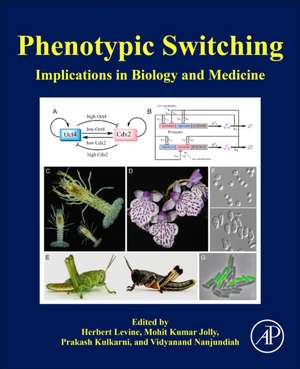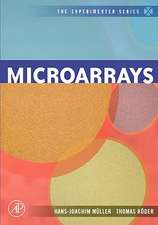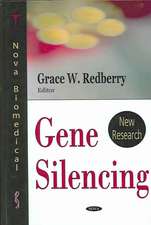Phenotypic Switching: Implications in Biology and Medicine
Editat de Herbert Levine, Mohit Kumar Jolly, Prakash Kulkarni, Vidyanand Nanjundiahen Limba Engleză Paperback – 8 iun 2020
This book is essential for active researchers, basic and translational scientists, clinicians, postgraduates and students in genetics, human genomics, pathology, bioinformatics, developmental biology, evolutionary biology and adaptive opportunities in yeast.
- Thoroughly addresses the conceptual, experimental and translational aspects that underlie phenotypic plasticity
- Emphasizes quantitative approaches, nonlinear dynamics, mechanistic insights and key methodologies to advance phenotypic plasticity studies
- Features a diverse range of chapter contributions from international leaders in the field
Preț: 1148.44 lei
Preț vechi: 1595.35 lei
-28% Nou
Puncte Express: 1723
Preț estimativ în valută:
219.77€ • 228.06$ • 183.70£
219.77€ • 228.06$ • 183.70£
Carte tipărită la comandă
Livrare economică 10-24 martie
Preluare comenzi: 021 569.72.76
Specificații
ISBN-13: 9780128179963
ISBN-10: 0128179961
Pagini: 762
Ilustrații: 250 illustrations (200 in full color)
Dimensiuni: 191 x 235 mm
Greutate: 1.29 kg
Editura: ELSEVIER SCIENCE
ISBN-10: 0128179961
Pagini: 762
Ilustrații: 250 illustrations (200 in full color)
Dimensiuni: 191 x 235 mm
Greutate: 1.29 kg
Editura: ELSEVIER SCIENCE
Public țintă
Active researchers, basic and translational scientists, clinicians, postgraduates, and students in the areas of genetics, human genomics, pathology, bioinformatics, developmental biology, evolutionary biology, and pharmaceutical science; medical students, clinical and laboratory genetics trainees (residents and fellows)Cuprins
1. The fundamentals of phenotypic plasticity
2. Rethinking the role of chance in the explanation of cell differentiation
3. Random walk across the epigenetic landscape
4. Maneuvering protein functions and functional levels by structural excursions
5. Prion-mediated phenotypic diversity in fungi
6. Bistability in virus - host interaction networks underlies the succes of hepatitis C treatments
7. Quantifyinh Waddington landscapes, paths, and kinetics of cell fate decision making of differentiation/development
8. The physics of cell fate
9. Disentangling the environmentally induced and stochastic development components of phenotypic variation
10. The evolution of cell differentiation in animals: biomolecular condensates as amplification hubs of inherent cell functions
11. Phenotypic switching and its evolutionary consequences
12. Cell-state organization by exploratory sloppy dynamics
13. Emergence of metabolic heterogeneity in cell populations: lessons from budding yeast
14. Stochastic phenotypic switching in endothelial cell heterogeneity
15. Regulation of phenotypic plasticity from the perspective of evolutionary developmental biology
16. Phenotypic plasticity and the origins of novelty
17. Niche construction and the transition to herbivory: Phenotype switching and the organization of new nutritional modes
18. NAture, nurture, and noise in bird song ontogeny as determinants of phenotypic and functional variation among dialects
19. Domestication as a process generating phenotypic diversity
20. The glycobiology of ovarian cnacer progression: phenotypic switches an microenvironmental influences
21.Epithelia-mesenchymal transition in cancer
22. Phenotypic switching and prostate diseases: a model proposing a causal link benign prostatic hyperplasia and prostate cancer
23. Phenotypic plasticty and lineage switching in prostate cancer
24. Implications of non-genetic heterogeneity in cancer drug resistance and malignant progression
25. Phenotypic plasticity: the emergence of cancer stem cells and collective cell migration
26. Adaptive phenotypic switching in breast cancer in response to matric deprivation
27. Phenotypic instability induced by tissue disuption at the origin of cancer
28. Evolutionary strategies to overcome cancer cell resistance ot treatment
2. Rethinking the role of chance in the explanation of cell differentiation
3. Random walk across the epigenetic landscape
4. Maneuvering protein functions and functional levels by structural excursions
5. Prion-mediated phenotypic diversity in fungi
6. Bistability in virus - host interaction networks underlies the succes of hepatitis C treatments
7. Quantifyinh Waddington landscapes, paths, and kinetics of cell fate decision making of differentiation/development
8. The physics of cell fate
9. Disentangling the environmentally induced and stochastic development components of phenotypic variation
10. The evolution of cell differentiation in animals: biomolecular condensates as amplification hubs of inherent cell functions
11. Phenotypic switching and its evolutionary consequences
12. Cell-state organization by exploratory sloppy dynamics
13. Emergence of metabolic heterogeneity in cell populations: lessons from budding yeast
14. Stochastic phenotypic switching in endothelial cell heterogeneity
15. Regulation of phenotypic plasticity from the perspective of evolutionary developmental biology
16. Phenotypic plasticity and the origins of novelty
17. Niche construction and the transition to herbivory: Phenotype switching and the organization of new nutritional modes
18. NAture, nurture, and noise in bird song ontogeny as determinants of phenotypic and functional variation among dialects
19. Domestication as a process generating phenotypic diversity
20. The glycobiology of ovarian cnacer progression: phenotypic switches an microenvironmental influences
21.Epithelia-mesenchymal transition in cancer
22. Phenotypic switching and prostate diseases: a model proposing a causal link benign prostatic hyperplasia and prostate cancer
23. Phenotypic plasticty and lineage switching in prostate cancer
24. Implications of non-genetic heterogeneity in cancer drug resistance and malignant progression
25. Phenotypic plasticity: the emergence of cancer stem cells and collective cell migration
26. Adaptive phenotypic switching in breast cancer in response to matric deprivation
27. Phenotypic instability induced by tissue disuption at the origin of cancer
28. Evolutionary strategies to overcome cancer cell resistance ot treatment
Recenzii
"This is a very high-quality book that targets a developing area of biological research and fully fleshes it out thanks to excellent authorship. The volume is intended for a fairly narrow and select audience. It provides a comprehensive
overview of the field as it stands today." --Doody
overview of the field as it stands today." --Doody

















